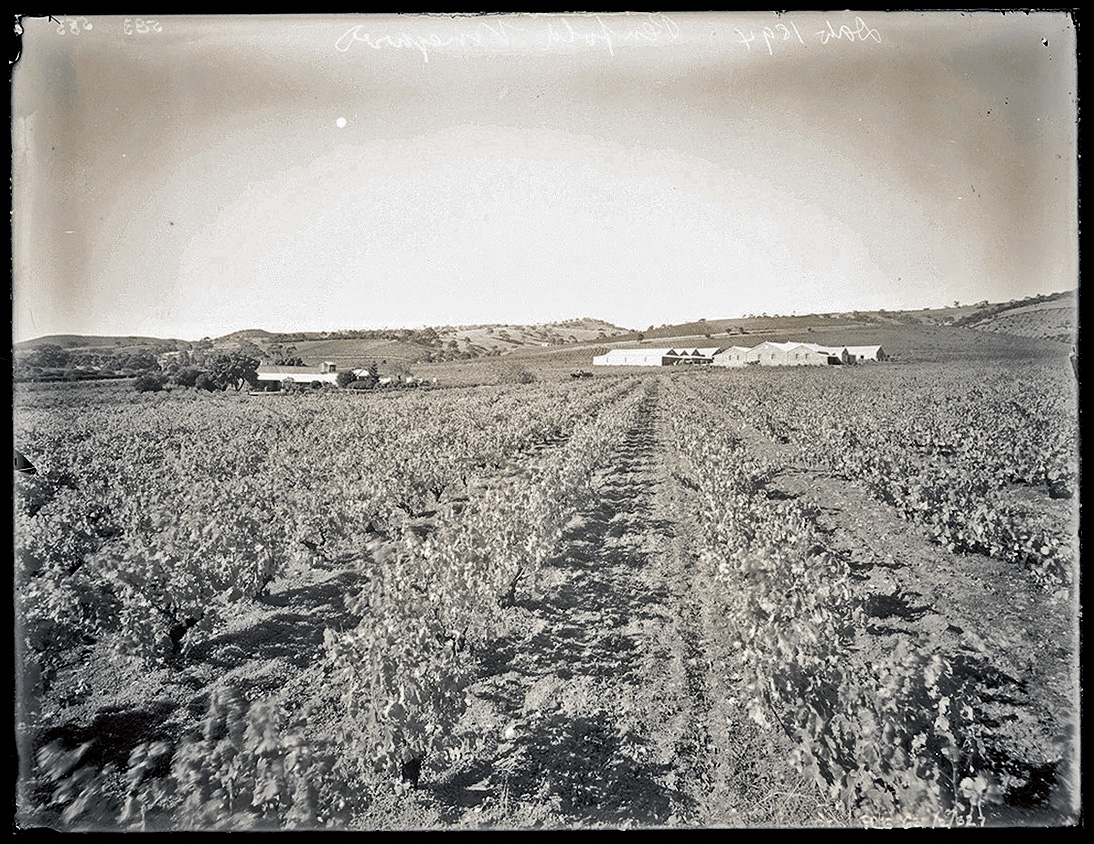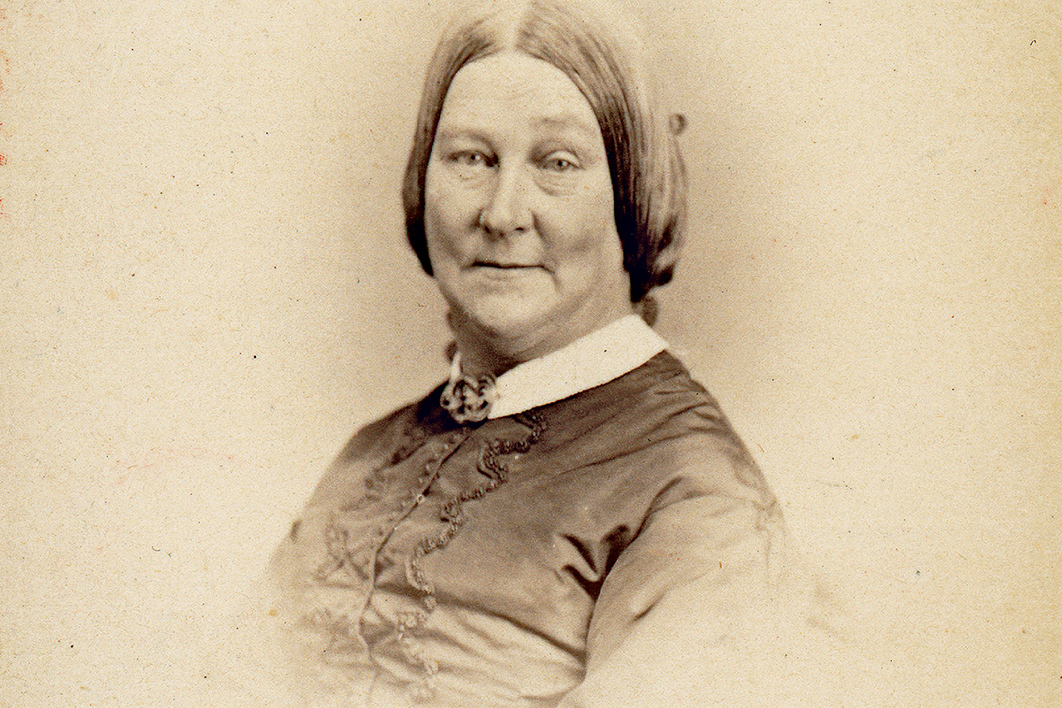Part of our collection of articles on Australian history’s missing women, in collaboration with the Australian Dictionary of Biography
Throughout her life Mary Penfold demonstrated shrewd skills in farm management, in selecting and directing employees, and in commerce. It was her practical approach to wine production, among other agricultural pursuits, that by the 1880s made Messrs Penfold & Co. the source of a third of all wines made in South Australia.
Born Mary Holt in London in 1816, she was the only child of a well-educated mother and a physician father. Mary came of age at the cusp of British imperial expansion following the end of the Napoleonic wars, received a fine education and benefited from her parents’ openness about financial affairs.
In 1835, Mary married medical student Christopher Rawson Penfold, one of thirteen children of a Sussex vicar and his wife. The evidence suggests that their union was characterised by mutual respect and great fondness. Christopher began practising medicine in Brighton in 1838, and two years later the couple welcomed their only child, Georgina.
When Georgina was four, the three of them sailed to South Australia with Mary’s paid companion, Ellen Kimbrell. Tellingly, the family’s luggage reportedly included a small collection of grapevine cuttings, of the French variety grenache, wrapped in canvas. Cuttings like these, which will replicate the parent vine, are the traditional means of establishing a vineyard.
The timing was propitious: while emigration agents in England were persuading Mary and Christopher to make a new home in South Australia, residents across the young Australian colonies increasingly saw wine production as a means of turning lands to profitable use. Reflecting successful experiments in the older colony of New South Wales, books circulated in London promoting vine-growing and winemaking as civilised pursuits that also increased land values.
Soon after arriving in Adelaide the Penfolds purchased a 500-acre (202-hectare) property eight kilometres east of the township, in the district of Magill in the Mount Lofty Ranges. Grange Cottage was already standing, and the property came with outbuildings and established crops. It was here that Mary, Ellen and other employees planted the imported vines, later transplanting and adding to them, probably with acclimatised wine grape varieties available for sale in Australia.
When Mary first made wine at the Grange in the 1850s, Ellen was at her side, and for some time it was Ellen who took responsibility for this branch of the growing enterprise, until her death the following decade. Neither woman had been trained in viticulture or winemaking. Some immigrants from continental Europe might have possessed the experience and confidence required to nurture wine grapes and manufacture and market wine in the Australian colonies, but British immigrant winegrowers of Penfold’s generation usually consulted the published advice of their colonial peers and relied on trial and error. The success of local growers meant that South Australia emerged as Australia’s largest wine-producing colony by the late 1860s.
Were there catalysts other than colonial immigration boosterism for Mary’s interest in the wine business? As she approached adulthood in London, it seems likely she would have been exposed to the fine wines that traditionally flowed from France, Portugal and Spain despite wartime restrictions on commerce.
Some credit must go to the growing belief that wine was linked to good health. British naval surgeons had long prescribed wine for a range of ailments, most notably to prevent scurvy on long journeys. The 1860s brought a pragmatic response from the British medical establishment to rising concerns about alcohol consumption in empire countries: if the working classes were going to drink alcohol, which seemed inevitable, then it should be wine free of the spirits used to fortify (or preserve) it for shipping. The wine drunk in Britain arrived by ship, and was often fortified, but in the Australian colonies drinkers could obtain their wine “pure,” without brandy or other additives.
Like some other colonial doctors, Christopher Penfold promoted the health benefits of “pure” wines compared with spirits and beer. But the volume of Penfold wines sold was surely due to all classes embracing colonial wine as a tipple as well as a tonic.
By 1869 the vineyard at the Grange covered sixty acres (twenty-four hectares). During the following decade Mary Penfold promoted her products in Adelaide with a simple classified newspaper advertisement for “Good Harvest Wines at the Grange, Magill,” and the property earned the name “Mrs Penfold’s.” She also started exporting red and white wines, made in styles from dry to sweet using grape varieties like grenache, tokay, madeira, frontignac, verdelho, mataro, Pedro Ximenez and muscat, to other Australian colonies and British India. Curiously, the wines were not well known in South Australia during this period, but they did win international prizes.
Although Penfold did not belong to the South Australian Vignerons’ Association — colonial women were excluded from such agricultural organisations — she corresponded with the association on matters of importance to her business. The high tariffs charged for wines entering Victoria, designed to protect local winegrowers, were an especial concern. Penfold strenuously petitioned Victorian authorities for their removal, and kept other vignerons informed of her activities.
When Christopher Penfold died at fifty-nine in 1870, after a career as Magill’s much-loved medico, Mary and Christopher’s son-in-law, the Melbourne civil servant Thomas Hyland, was acting as an agent for Penfold’s wines. Hyland assumed Mary would be unable to manage the business without Christopher and suggested that he broker the sale of the Grange. Mary rejected this offer and instead entered into partnership with the humbled Hyland. Fellow South Australian wine entrepreneur Joseph Gillard joined the business as cellar manager.

Penfold’s vineyards at Magill, photographed in 1894 by Ernest Gall. Hindmarsh Collection/State Library of South Australia PRG 631/2/327
Descriptions of Penfold’s winery in the 1870s and 1880s reveal a modern, impeccably ordered plant. Mary was an early adopter of steam-powered crushing and built up-to-date concrete vats for fermenting grape juice. Large volumes of wine were held in barrels of varying size, coopered from Australian and imported timbers. By the 1880s, corked and labelled bottles from the Grange were foil-capsuled on site, with a machine for the purpose.
A decade after Christopher’s death, Penfold, Hyland and Gillard negotiated a new business contract for Mary to remain as winemaker and seller for a further seven years and to receive 10 per cent of the company’s profits. But in 1884, aged sixty-eight, Mary Penfold handed business management to Gillard. She remained at the Grange, where her magnificent ornamental garden, and the wider property, commanded an arresting view towards the growing city of Adelaide.
Ellen Kimbrell had died before Christopher, and in 1872 Mary’s granddaughter, Inez Penfold-Hyland, aged eight years, moved from Melbourne to keep her company. The pair shared a prodigious affection, with Mary taking responsibility for Inez’s education and later encouraging her granddaughter’s literary pursuits, until the younger woman’s death, at the Grange, in 1892.
Mary’s devotion to her only granddaughter is evident in her curation and publication in 1893 of Inez K. Hyland’s verse and short prose collection, In Sunshine and in Shadow. According to one review, the volume had been produced by a “mind of great power, of high aim.” It featured promising Australian nature poetry “full of beauties,” while possessing sharp sarcasm, especially on matters of men, power and religion. Mary Penfold’s nurturing of her granddaughter’s creativity speaks of her own wit and inclinations as a lover of nature with a keen eye for colonial habits and vernacular.
After Inez’s death, Mary left the Grange to live in Melbourne with Georgina and Thomas, and died there, aged seventy-nine, after a painful illness. Her body was transported to Magill on the Melbourne-to-Adelaide train service she had so enthusiastically welcomed, to be interred alongside her husband and granddaughter at St George’s Church, Woodforde, Magill. She was survived by her daughter Georgina, son-in-law Thomas and grandson Leslie Penfold Hyland. •
Further reading
“Mrs Penfold’s Wine Manufactory, Magill,” SA Register, 4 June 1874
Pioneer Women, Pioneer Land: Yesterday’s Tall Poppies, by Susanna De Vries, Angus & Robertson, 1987




